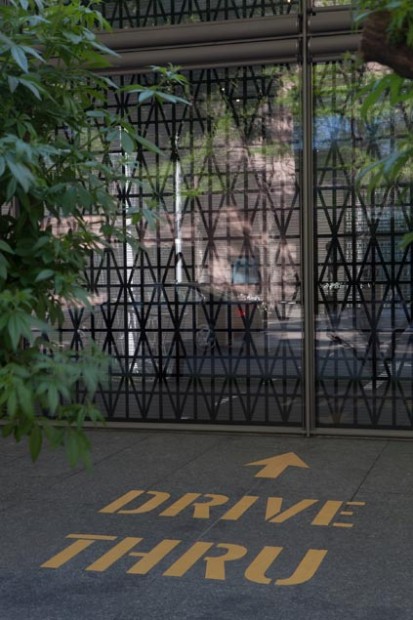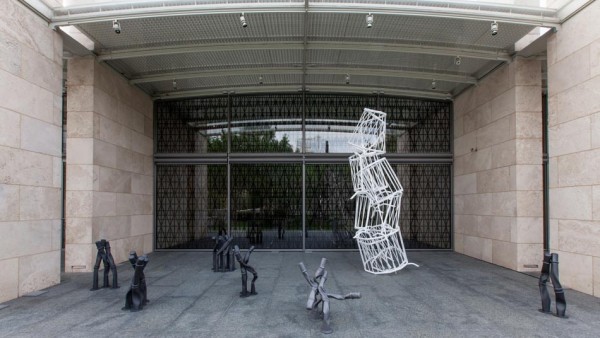There is something oddly satisfying about walking into a blacktopped gallery. In the new work by German artist Bettina Pousttchi at the Nasher Sculpture Center in Dallas, the pairing of the playful rubber floor with canonical works from the past immediately alerts the viewer that her installation is both thought-provoking and satirical.

Upon entering the gallery, a path of painted white lines, guides the viewer past works selected from the museum’s permanent collection. On either end of the room, the Nasher’s windows have been covered in enormous vinyl decals that mimic scissor gates, the kind one might expect to see pulled over shop windows for protection at night. The photographic decals, which Pousttchi has used in previous works, is entirely convincing and tricks the viewer into believing momentarily that the Nasher has indeed installed security gates. Outside the rear window, a series of Pousttchi’s bent street bollards and another crowd barrier sculpture reinforce the connection to roadways and street scenes. On the pavement outside the front window, painted in yellow is an arrow pointing into the gallery paired with the words “DRIVE THRU,” leaving little doubt as to how the viewer should proceed.

According to the artist, the work references Ross Avenue’s history as “Automobile Row,” an allusion to the parking lots and gasoline stations that preceded the museum on the site. While this makes sense in relation to Pousttchi’s larger body of work dealing with urban spaces, memory, and history, the connection seems more like an amusing tidbit and less like the driving force behind this work. What seems more interesting, and perhaps more attainable to visitors unaware of the history of Ross Avenue, is that this work is a commentary on how the contemporary viewer looks at art.
Of the two roads marked on the rubber floor, one leads to the other galleries, the other leads to the Museum’s cafe, making for an all-too-knowing wink at visitors and suggesting that both galleries and cafe factor equally into the museum-going experience. This drive-thru mentality, stopping briefly to look at the work on one’s way to grab a snack and coffee, seems all too pertinent given the recent Art Everywhere US project happening across the street at the Dallas Museum of Art. Though it may not have been her intention, Pousttchi’s installation of a satirical criticism of a drive-thru museum across the street from one of the institutions spear-heading a project to promote passive looking at artwork on billboards and bus shelters, is a timely commentary on the project.
The sculptures Pousttchi selected for the installation are an interesting array of different styles and subjects, ranging from abstractions by Alexander Calder and John Chamberlain to figural works by Pablo Picasso and Constantin Brancusi. No genre of work is spared the tongue-in-cheek slight of becoming a roadside attraction.

Pousttchi’s crowd barrier and neon work Double Monuments for Flavin and Tatlin X (2010) is also subjected to this designation. Displayed alongside the Nasher’s works, this large construction positions Pousttchi’s own artwork in dialogue with two very different modern giants. It does not come across as an arrogant inclusion, but rather as a warranted nod to the past and a recognition of its ongoing relevance today.

Pousttchi sculptures on the Nasher terrace.
Presenting the works on a fabricated roadway prompts reconsideration not only of the artwork, but also of how the artwork is experienced: passively or contemplatively. Simultaneously critical and satirical, this installation presents viewers with an intelligent work that is worth experiencing and contemplating on their next joyride through Dallas’ art scene.
Bettina Pousttchi: Drive Thru Museum will be on view at the Nasher Sculpture Center from April 12-July 13, 2014.


